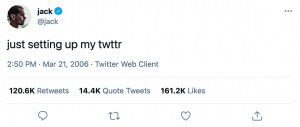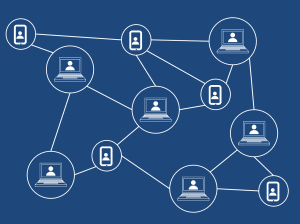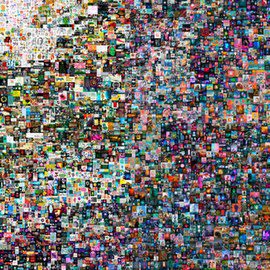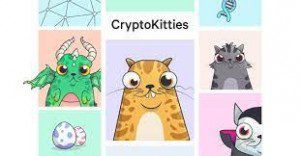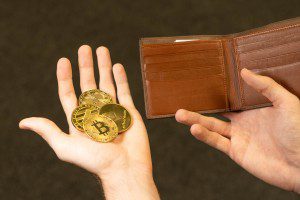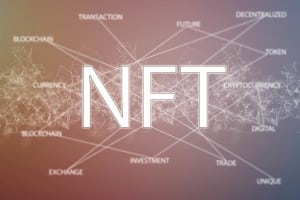What are NFTs?
An NFT stands for a non-fungible token. (“Non-fungible” like a one-of-a-kind piece of artwork means that it is unique and cannot be replaced.) NFTs are digital collectibles for the modern age that represent a wide range of assets (JPEGs, GIFs, tweets, songs, computer games). Despite their rather abstract concept, NFTs are indeed assets and they make real money. As with all collectables, the rarer people consider the item to be, the more they are willing to pay.
Although any digital asset can arguably be “owned” insofar as one might right click and save an image, for example, this only makes a copy. A true collector will only want the original.
Digital assets that acquire NFT status are originals – not copies, and they can be proven as such. They have an electronic fingerprint by being attached to a digital token that qualifies them as the original item. The non-fungible token on a blockchain thus points to a digital asset of value that a buyer or collector could cherish.
This is what makes NFTs so special – the historical problem of copying and thus counterfeiting original art is solved – as long as the investor does not mind owning an asset that is 100% digital. By providing an indelible ledger – with transactions automatically written and recorded – Blockchain technology (to be explained shortly) ensures all NFTs are originals.
For example, the first-ever tweet on Twitter shown here was sold to Sina Oracle, the CEO of Bridge Oracle for 2.9 million dollars. Although anyone can easily view this tweet online, Sina Estav now owns the NFT associated with that tweet as “signed and verified” by co-founder and former CEO of Twitter, Jack Dorsey. In other words, Sina Estav’s ownership of the first ever tweet is evidenced with a unique data signature attached to it – giving Estav exclusive “bragging rights”.
Provided that a digital work becomes collectible and tradable, it is possible for creators to make lifetime commissions from the NFTs produced while still retaining the copyrights and reproduction rights for any work produced. This is because of so-called ‘smart contracts’ which ensure the seller gets paid automatically when their NFTs switch hands to the new owner.
NFTs would have no value and zero spending power without a digital record known as the blockchain.
What are blockchains?
A blockchain is a public ledger which records every single transaction that takes place on it. As all transactions on the blockchain are public and viewable, the ledger provides an indelible record and does not need an accountant to oversee the numbers.
A blockchain has an “auto-leger” aspect which enables people to make business transactions from anywhere for anything without providing any sensitive information like names and credit card information. This anonymity afforded, and the consequent protection from theft, makes cryptocurrency and NFTs very appealing.
It is impossible to create a counterfeit NFT because the record of the NFT is indelibly displayed on the blockchain. Any NFT can be looked up and verified on the blockchain.
The Internet has thus created a way of making a digital asset valuable by ensuring that the asset cannot be replicated.
A few noteworthy examples of NFTs:
Metarift
Metarift is a looping video GIF showing a group of reflective spheres cocooned within an infinity symbol. Created by the artist who goes by the pseudonym, Pak, this NFT sold for $904,413.
Everydays – The first 5000 days
The artist, Beeple, made a collage of digital art (one for every day since May 2007) called, Everydays – The first 5000 days. The NFT associated with this digital artwork sold for over $69 million.
CrytoKitties
Representing a series of NFTs worth millions of dollars, a CrytoKitty is unique and can be “bred” with others, leading to the creation of new kitties containing unique digital DNA. The CrytoKitties series became so popular in 2017 that the Ethereum blockchain, which stored these NFTs, was temporarily brought to a halt.
What are the different parts of an NFT?
Every non-fungible token consists of two parts. There is the token itself that is stored on the blockchain, and then there is its associated asset, whether it is a piece of digital artwork, a video or any other type of digital asset.
Unlike cryptocurrencies, NFTs are defined by their unique properties rather than any innate value. The value of NFTs, as with any collectible, is decided by what people are willing to pay for them.
It is the token and not the digital asset, that determines the uniqueness of the NFT. Likewise, it is the NFT, not the digital asset, that is stored and indelibly recorded on the blockchain.
It is possible, however, that an unscrupulous person could mint a copyrighted digital asset as an NFT and sell it. If you were to buy such an NFT, and the government later seized the digital asset under copyright law, your NFT on the blockchain would be of no use or value.
What does ‘fungibility’ mean?
Fungibility refers to an item’s uniqueness or lack thereof.
A fungible item can be replaced by another identical item. For example, a one-dollar bill is fungible because it can simply be replaced with another one-dollar bill – irrespective of when that dollar bill was printed. Likewise, any cryptocurrency is fungible; Bitcoin is fungible because one Bitcoin always equals one Bitcoin.
Each NFT is unique – there is not anything like it anywhere in cyberspace, the cloud, or in local storage. This is thanks to the digital signature assigned to it on the blockchain.
Where to buy and invest in NFTs?
A key point to understand is that there is a difference between an NFT marketplace and the role that the blockchain plays for NFTs.
Where the NFT marketplace is a one-stop shop to buy, sell and display your NFTs, a blockchain is basically the database that records all transactions taking place in this shop.
The list of NFT marketplaces is continually growing. Some of the most well-known NFT marketplaces include: Nifty Gateway (popular with celebrities), SuperRare (renowned for exclusivity), Async Art (for programmable art), MakersPlace (great for collaboration), OpenSea (known for its variety of NTFs), Rarible (community-owned), Foundation (with a mission to constantly innovate art), MythMarket (gaming-focused), BakerySwap (an NFT supermarket and crypto hub), KnownOrigin (focusing on art-centric authenticity), Enjin Marketplace (strong game presence using its own blockchain) and Portion (makes it possible to manage physical and digital collections in one place).
All of these marketplaces offer a page for minting new NFTs and this process is just as straightforward as uploading a picture to the Internet and adding a caption.
How do you buy or create NFTs?
You must start with a crypto wallet for your NFTs and profits to live in. It is not possible to purchase cryptocurrency or NFTs without having some kind of crypto wallet.
A crypto wallet holds proof of your digital cash as well as storing the public and private keys required to buy any cryptocurrency or NFT, providing digital signatures to authorise each transaction.
Just as there are various blockchains, there are many different wallets, and they are not all compatible with each other or the marketplaces.
These wallets that interact with the blockchain to enable transactions can take the form of an online app, website or even physical device that you carry around with you. The priority with these wallets is to protect your keys the same way you would protect your passwords, since these keys are what allow you to buy or trade your cryptocurrency or NFTs.
What blockchains are there?
Ethereum
Ethereum is where NFTs were born. More than just a blockchain, Ethereum is a solid development platform. However, the technology Ethereum uses is outdated and does not handle scaling very well. Ethereum was brought to a screeching halt, for example, by the mass buying and selling of CrytoKitties. There are also concerns about its energy efficiency; TechCrunch pointed out in March 2021 that each NFT transaction burns as much energy as two American households in a single day.
Flow
Having learnt from Ethereum’s mistakes, Flow has very fast transactions which are also low cost. Specifically built with NFTs in mind, especially those to do with games, Flow also enables developers to create applications called dApps.
Wax
Wax is the blockchain most focused on video games and virtual worlds. This blockchain prides itself as having a carbon-neutral system. In their own words, Wax ‘don’t need supercomputers to wage an energy-sucking battle to complete a single transaction. It’s a lean, green NFT minting machine.’
Tron
Unlike most blockchains, which are confined to the use of certain countries, Tron is international, as art its users. The Tron blockchain ecosystem allows users to freely publish, store, and own data.
Polkadot
Polkadot has a mission to build bridges between multiple blockchains. This means, regardless of which cryptocurrency you use or which blockchain you use to mint NTFs, you can exchange information and transactions across independent blockchains.
Tezos
Tezos is as secure as Ethereum but uses a fraction of the energy processing NFTs. Tezos has a lively community and a very high NFT engagement in all areas of buying, selling, minting and trading.
While each blockchain tends to be its own universe, which is closed to the users of other systems, any of these examples provided are good options for getting into the NFT scene. You simply need to decide the sort of people you would like to do business with (e.g., artists or gamers), your preferred cryptocurrency, the type of wallet you intend to use, and ensure the NFTs themselves are all compatible.
Why invest in NFTs?
The demand for NFTs is driven, in the first instance, by collectors. The opportunity to own anything that is one of a kind has always been regarded as valuable to some extent.
Artists themselves are also drawn to the world of NFTs. In fact, NFTs can be seen to have originated with the need of artists to protect themselves and their work from theft and plagiarism.
Previously, artists’ work did not have a fraction of the reach that their artwork had, and there was no control over who shared their work – this limited the monetary compensation an artist might have received had their work received the credit was due. The digital world thus needed to change in order to give legal rights to artists as well as a say in how their artwork could be used.
Giving an artist’s work a unique means of identification, by connecting the artwork to a blockchain, an artist can see everywhere his or her artwork goes and, most importantly, it can be traced back to its origin.
Another reason people have been attracted to NFTs is because of the recent phenomenon known as ‘recreational investing’. For those with time on their hands and money to spend, NFTs represent an entertaining way to spend money.
Important Points to Consider Before Investing in NFTs
The NFT world is currently highly unregulated – which creates both opportunities (conditions are ripe for relatively easy money to be made) as well as potential problems (there are plenty of dubious sales pitches).
The reason this market is so profitable at the moment is because of how new it is – governments do not yet know how to tax NFTs. In spite of the energy consumed by the NFT business, creators are unlimited in how many NFTs they can mint and are putting them up for sale across multiple marketplaces. Collectors, in turn, are busily buying up those NFTs considered exclusive and scarce digital assets. Investors are further fuelling the demand by buying and holding a diverse range of NFTs with the view to flip them at a profit.
While money can certainly be made by selling NFTs, it is important to understand that NFTs cost money to be stored or sold on the blockchain.
Moreover, although it is impossible to counterfeit an NFT, a potential investor cannot easily tell if the sales pitch is accurate or not. Persuasive sales pitches can frame a digital artwork as a highly valuable asset when in fact it is worthless. Investors eager to get on the NFT bandwagon should be careful to check exactly where an NFT has originated and if its creator is going to be worth investing in.
Another point to consider is that the intangibility of NFTs creates a whole range of incidental factors that could threaten their security (e.g., theft of digital keys or possible server problems). That being said, as with investment in any valuable asset, you simply need to learn how to take care and ensure you have security safeguards in place.
NFT artwork carries more of a personal touch than say, the stock market. The investor should be prepared therefore to get emotionally invested to some extent in the digital artwork itself.
This can actually have a positive impact for the digital artists / creators (and in turn the investors) because when an artist realises that others are emotionally invested in their work, it becomes a motivator to produce more exclusive pieces of art. This leads to a positive upward investment spiral, fuelling the minting, buying and selling of ever-increasing numbers of NFTs for the artist. Obviously, if you are one of the first people to discover a successful and upcoming artist in the NFT world, all the better. Your investments serve as an incentive for the artist to keep going.
Remember, as far as you can, form a positive attachment to artists who you predict will be successful. For example, give likes, leave comments, share their work far and wide. All of these actions serve to help will help them to produce higher-quality work faster. Just as you would with any other collectible, once you believe the market conditions will earn your artwork a higher price than that which you paid, it is simply a matter of selling the NFT to make a profit.
By successfully selling an artist’s work, that too further encourages the artist. Smart contracts for the artist’s work enable them make additional profit each time an NFT attached to their artwork is sold.
How to get started with buying and selling NFTs?
Start small. Set aside a dedicated fund to start investing in NFTs and carefully research which NFTs are worth your time. Begin by seeing if you can buy just one NFT for a relatively small amount and then sell for a hundred or so dollars more. Then see if you can buy several NFTs to sell for this same markup. Develop your confidence in the process before making bigger purchases. Then follow the classic formula of buying a high volume of NFTs at relatively low prices.
Most NFT market places function like an auction (similar to eBay). After you place a bid, you wait to see of you have won. Some NFT marketplaces also allow you the option of buying straightway at a fixed price instead of having to bid.
You should be looking for NFT bargains (creators who are also just coming onto the scene). If the creator is to have a successful future, you could be taking advantage of their modest beginnings and you can wait to see their value increase over time. As the name of the creator gets bigger, the popularity surrounding the kind of NFT they create increases, which means you can flip the NFT and make a profit on what you have bought.
An interesting point to consider is that it is not necessarily the talent of the creator which is key to their success – it is reach and exposure. Digital creators who are able to capture people’s attention are the most prolific.
Some of the best NFTs to invest in right now include digital art, sports cards and domain names. Good luck!

